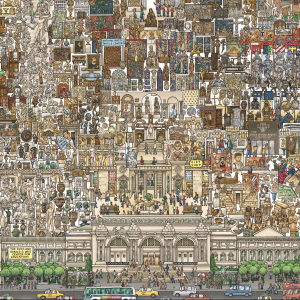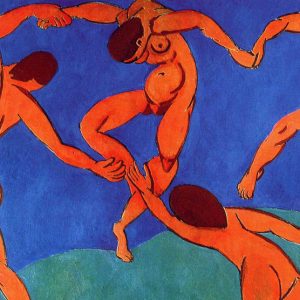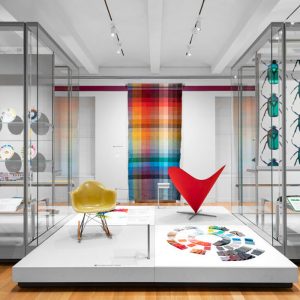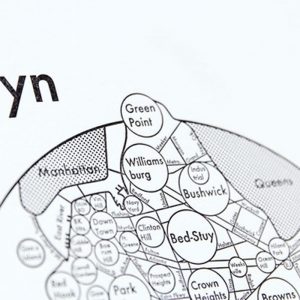Link About It: This Week’s Picks
Celebrating trans love, the return of a design icon, maps from the mind, ancient inventions gain new life and more

GLAAD’s #TransLoveStories Portraits for Transgender Day of Visibility
 31 March marked the 10th annual Transgender Day of Visibility (TDOV), observed worldwide to celebrate trans people everywhere. Representation is vital, always, and especially when it portrays trans individuals finding and sharing love. To honor the occasion, GLAAD is highlighting relationships in the trans community through their #TransLoveStories campaign. NYC-based photographer Landyn Pan captured tender moments through heartwarming couples portraits. GLAAD and Instagram will roll out these IGTV videos and photos in the week following TDOV. Head over to GLAAD to learn more, or to their Instagram page.
31 March marked the 10th annual Transgender Day of Visibility (TDOV), observed worldwide to celebrate trans people everywhere. Representation is vital, always, and especially when it portrays trans individuals finding and sharing love. To honor the occasion, GLAAD is highlighting relationships in the trans community through their #TransLoveStories campaign. NYC-based photographer Landyn Pan captured tender moments through heartwarming couples portraits. GLAAD and Instagram will roll out these IGTV videos and photos in the week following TDOV. Head over to GLAAD to learn more, or to their Instagram page.
Forecasting Artificial Intelligence’s Impact on Architecture
 ArchDaily has compiled a list of six “visions” portraying how artificial intelligence may change architecture, relying on MIT Professor Max Tegmark’s quote as the foundation for the discussion: “We are all the guardians of the future of life now as we shape the age of AI.” The six predictions—which were originally displayed at the Shenzen Biennial Eyes of the City exhibition—range from buildings with the ability to vocally interact with its inhabitants to the installation of “hidden eyes and ears,” which could deter crime and corruption, but (like all AI) it is a “a Pandora’s Box of possibilities.” Read more at ArchDaily.
ArchDaily has compiled a list of six “visions” portraying how artificial intelligence may change architecture, relying on MIT Professor Max Tegmark’s quote as the foundation for the discussion: “We are all the guardians of the future of life now as we shape the age of AI.” The six predictions—which were originally displayed at the Shenzen Biennial Eyes of the City exhibition—range from buildings with the ability to vocally interact with its inhabitants to the installation of “hidden eyes and ears,” which could deter crime and corruption, but (like all AI) it is a “a Pandora’s Box of possibilities.” Read more at ArchDaily.
A Forest Submerged for 60,000 Years Might Provide New Medicines
 A massive underwater forest buried beneath 10 feet of sand sat preserved in the Gulf of Mexico for nearly 60,000 years until Hurricane Ivan uncovered it in 2004. The forest’s bare cypress trees then became subject to shipworms, a wood-eating creature with an insatiable appetite. Researchers are collecting these worms (60 feet under) to study their chemical potential to produce live-saving medicines. They must move quickly, though: when a new habitat is formed, animals rapidly compete for survival, and “territory disputes kick up a lot of chemistry,” JoAnna Klein writes. It’s the researchers’ hope that somewhere hidden underground are the elements for non-toxic drugs designed to treat cancer and ease chronic pain. Read more at The New York Times.
A massive underwater forest buried beneath 10 feet of sand sat preserved in the Gulf of Mexico for nearly 60,000 years until Hurricane Ivan uncovered it in 2004. The forest’s bare cypress trees then became subject to shipworms, a wood-eating creature with an insatiable appetite. Researchers are collecting these worms (60 feet under) to study their chemical potential to produce live-saving medicines. They must move quickly, though: when a new habitat is formed, animals rapidly compete for survival, and “territory disputes kick up a lot of chemistry,” JoAnna Klein writes. It’s the researchers’ hope that somewhere hidden underground are the elements for non-toxic drugs designed to treat cancer and ease chronic pain. Read more at The New York Times.
NASA’s Iconic “Worm” Logo Returns
 To celebrate the return of human spaceflights from the USA, NASA has resurfaced their beloved, iconic “worm” logo. The announcement came with a photo of a Falcon 9 rocket—emblazoned with the retro insignia—which will take astronauts to the International Space Station for SpaceX’s Demo-2 expedition. Designed in 1974 by Richard Danne and Bruce Blackburn, the worm was retired in 1992 and replaced by the Meatball, which remains NASA’s primary symbol. Regardless, design enthusiasts all over the world relish the bold, modernist worm’s triumphant return. See more at Ars Technica.
To celebrate the return of human spaceflights from the USA, NASA has resurfaced their beloved, iconic “worm” logo. The announcement came with a photo of a Falcon 9 rocket—emblazoned with the retro insignia—which will take astronauts to the International Space Station for SpaceX’s Demo-2 expedition. Designed in 1974 by Richard Danne and Bruce Blackburn, the worm was retired in 1992 and replaced by the Meatball, which remains NASA’s primary symbol. Regardless, design enthusiasts all over the world relish the bold, modernist worm’s triumphant return. See more at Ars Technica.
John Kerschbaum’s Epic, Illustrated Map of the Metropolitan Museum of Art
 Commissioned in 2004 and published in 2007, artist John Kerschbaum’s captivating, hand-drawn Family Map weaves hundreds of artistic highlights into a complete floor plan of the Metropolitan Museum of Art. In fact, Kerschbaum depicts every gallery in the institution on one single 18-by-24-inch page. He did so through combining hundreds of reference sketches made through countless visits to the beloved museum. “Each department head gave me 50 of their most important pieces that are almost always on display,” Kerschbaum says to Atlas Obscura. “I’d have a floor plan of the museum and a clipboard, and I’d make notes of where each item was, either by name or a quick sketch.” See the entire map at Atlas Obscura, where you can read even more about its development.
Commissioned in 2004 and published in 2007, artist John Kerschbaum’s captivating, hand-drawn Family Map weaves hundreds of artistic highlights into a complete floor plan of the Metropolitan Museum of Art. In fact, Kerschbaum depicts every gallery in the institution on one single 18-by-24-inch page. He did so through combining hundreds of reference sketches made through countless visits to the beloved museum. “Each department head gave me 50 of their most important pieces that are almost always on display,” Kerschbaum says to Atlas Obscura. “I’d have a floor plan of the museum and a clipboard, and I’d make notes of where each item was, either by name or a quick sketch.” See the entire map at Atlas Obscura, where you can read even more about its development.
Ancient Egyptian Pigment Now Used in Molecular Biology
 The bright and striking pigment known as Egyptian Blue (or calcium copper silicate) was invented 5,000 years ago but continues to fascinate, now through the scientific insight it provides. The pigment (most famously featured on the Bust of Nefertiti, 1345 BC) has proven itself useful in biology research, as nanoscale mineral sheets of it essentially light up molecular imaging. A description of an imaging experiment explains it best: scientists “put the particles into a plant’s leaves, and compared it with another molecule commonly used to study in near-infrared imaging. Leaves are tricky because they fluoresce slightly on their own. But the researchers showed that the Egyptian Blue-containing leaf lit up bright, visible without a microscope, while the other molecule’s light was hidden in the leaf’s own fluorescence.” These near-infared imaging capabilities mean that the ancient pigment could be life-changing, some 5,000 years later, whether in further research, biomedical imaging or even image-guided surgery. Read more at Smithsonian Magazine.
The bright and striking pigment known as Egyptian Blue (or calcium copper silicate) was invented 5,000 years ago but continues to fascinate, now through the scientific insight it provides. The pigment (most famously featured on the Bust of Nefertiti, 1345 BC) has proven itself useful in biology research, as nanoscale mineral sheets of it essentially light up molecular imaging. A description of an imaging experiment explains it best: scientists “put the particles into a plant’s leaves, and compared it with another molecule commonly used to study in near-infrared imaging. Leaves are tricky because they fluoresce slightly on their own. But the researchers showed that the Egyptian Blue-containing leaf lit up bright, visible without a microscope, while the other molecule’s light was hidden in the leaf’s own fluorescence.” These near-infared imaging capabilities mean that the ancient pigment could be life-changing, some 5,000 years later, whether in further research, biomedical imaging or even image-guided surgery. Read more at Smithsonian Magazine.
The Cut’s Guide to Taking Nudes
 From tapping into the power of natural light to embracing spontaneity (instead of overtly staged works), The Cut’s five-step guide to taking a naked photograph aims to empower adults stuck inside and perhaps away from their consenting sexual partner/s. Whether or not one has a full-length mirror, the publication offers tips and tricks—make use of a bed or bathtub—that enhance the power of mood and suggestion. Read more at The Cut.
From tapping into the power of natural light to embracing spontaneity (instead of overtly staged works), The Cut’s five-step guide to taking a naked photograph aims to empower adults stuck inside and perhaps away from their consenting sexual partner/s. Whether or not one has a full-length mirror, the publication offers tips and tricks—make use of a bed or bathtub—that enhance the power of mood and suggestion. Read more at The Cut.
NBA Players in Televised Video Game Tournament
 In the absence of official NBA games, the league strengthened their pre-existing relationship with popular video game NBA 2K to co-host a bracketed, televised video game tournament. Players—including Brooklyn Nets’ all-star Kevin Durant, Denver Nuggets rookie Michael Porter Jr and others—will participate in the tournament, which will be televised on ESPN and last 10 days. The finer details of the tournament have yet to be released, but given the popularity of NASCAR’s virtual replacement (which drew 903,000 viewers) and ESPN’s higher profile, this could appease basketball fans and draw an entirely new audience. Read more at Bleacher Report.
In the absence of official NBA games, the league strengthened their pre-existing relationship with popular video game NBA 2K to co-host a bracketed, televised video game tournament. Players—including Brooklyn Nets’ all-star Kevin Durant, Denver Nuggets rookie Michael Porter Jr and others—will participate in the tournament, which will be televised on ESPN and last 10 days. The finer details of the tournament have yet to be released, but given the popularity of NASCAR’s virtual replacement (which drew 903,000 viewers) and ESPN’s higher profile, this could appease basketball fans and draw an entirely new audience. Read more at Bleacher Report.
The American Society of Magazine Editors’ 2020 Cover Contest
 Each year the American Society of Magazine Editors (ASME) holds the Ellie Awards to celebrate distinguished reportage, emerging talent, decades-long achievements, and more. Separately, they host a cover contest. This year’s finalists (of which there are over 200) include submissions from Bon Appetit, Playboy, Garage, The New York Times Magazine, 5280 Magazine, TIME, The New Yorker and many more. Voting is open for the month of April, with the winner being the cover with the most likes on Facebook. Head to ASME’s page to vote.
Each year the American Society of Magazine Editors (ASME) holds the Ellie Awards to celebrate distinguished reportage, emerging talent, decades-long achievements, and more. Separately, they host a cover contest. This year’s finalists (of which there are over 200) include submissions from Bon Appetit, Playboy, Garage, The New York Times Magazine, 5280 Magazine, TIME, The New Yorker and many more. Voting is open for the month of April, with the winner being the cover with the most likes on Facebook. Head to ASME’s page to vote.
How Museums Protect and Highlight Artworks
 Plenty of design decisions and details in museums (from glass display cases to pedestals, lighting and flippable panels) keep artworks and artifacts safe, but also highlight each piece for viewers without distracting them. With help from Goppion (a leading provider of museum cases), Lilly Cao for ArchDaily explains the many factors taken into consideration when displaying art. From conservation to interaction, there are minute details that the average museum-goer would never notice. Read about it at ArchDaily.
Plenty of design decisions and details in museums (from glass display cases to pedestals, lighting and flippable panels) keep artworks and artifacts safe, but also highlight each piece for viewers without distracting them. With help from Goppion (a leading provider of museum cases), Lilly Cao for ArchDaily explains the many factors taken into consideration when displaying art. From conservation to interaction, there are minute details that the average museum-goer would never notice. Read about it at ArchDaily.
Archie Archambault’s GPS-Free “Map From the Mind” Project
 Designer Archie Archambault creates circular city maps using information from locals and his own cellphone-free exploration. His “Map From the Mind” project began in Portland, thanks to a friend who made a quick map for Archambault when he moved to town. With that friend’s permission, Archambault set off to create the same kind of maps for more and more US cities. Various parks, neighborhoods and significant parts of town become bubbles on Archambault’s maps, each of which he completes after a stint in that city. “It’s a funny challenge to turn [the GPS] off when you go to a new place,” he says, “And it’s kind of alarming how resourceful you get.” As Linda Poon adds, in her story for CityLab, this kind of exercise is beneficial for our brains, which are able to “do sophisticated mapping work, relying on everything from the smell of the city to the feel of a cracked sidewalk.” Read more at CityLab.
Designer Archie Archambault creates circular city maps using information from locals and his own cellphone-free exploration. His “Map From the Mind” project began in Portland, thanks to a friend who made a quick map for Archambault when he moved to town. With that friend’s permission, Archambault set off to create the same kind of maps for more and more US cities. Various parks, neighborhoods and significant parts of town become bubbles on Archambault’s maps, each of which he completes after a stint in that city. “It’s a funny challenge to turn [the GPS] off when you go to a new place,” he says, “And it’s kind of alarming how resourceful you get.” As Linda Poon adds, in her story for CityLab, this kind of exercise is beneficial for our brains, which are able to “do sophisticated mapping work, relying on everything from the smell of the city to the feel of a cracked sidewalk.” Read more at CityLab.
Link About It is our filtered look at the web, shared daily in Link and on social media, and rounded up every Saturday morning.












